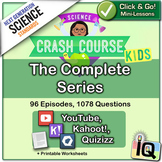Crash Course Kids, Matter and Its Interactions | Digital & Printable
- PDF
- Internet Activities
What educators are saying
Also included in
- Learn about Earth’s Systems, Ecosystems, Forces, Matter, and more! Point and Click for instant Science Mini-Lessons with Game-Based Assessment using Quizizz and Kahoot!• This ZIP file contains all nine of my Crash Course Kids Science IQ products, previously published individually, PLUS a compiled PDPrice $29.99Original Price $40.46Save $10.47
Description
Learn about solids, liquids, gases, mixtures, solutions, and more!
Point and Click for instant Physical Science Mini-Lessons with Game-Based Assessment using Quizizz and Kahoot!
• This PDF document includes organized hyperlinks to educational video content and digital interactive quizzes. Optional printable worksheets are included.
• For each YouTube episode, the quiz is available using two separate platforms: Kahoot and Quizizz. Every multiple-choice question includes a related screenshot from the video (images used with permission).
• Students can use any internet connected device, working individually or in groups, to input their responses.
Crash Course Kids Episodes:
#1 - What's Matter? (three states of matter: solid, liquid, and gas)
#2 - Part(icles) of Your World (how matter can change states)
#3 - Hunting for Properties (describing and measuring properties)
#4 - Measurement Mystery (using properties to solve a mystery)
#5 - Wood, Water, and Properties (how properties help us understand objects)
#6 - The Science of Lunch (malleability, hardness, conductivity, and magnetism)
#7 - The Great Picnic Mix Up (different mixtures and solutions)
#8 - Chemical Changes (indicators of a chemical change)
#9 - Vacation or Conservation (how Conservation of Mass actually works)
#10 - LEGO Block Party (chemical reactions and the Conservation of Matter)
#11 - Organizing Properties (group materials by their properties)
#12 - What's My Property? (describing metals and unknown substances)
#13 - Material World (making new materials and improving old ones)
#14 - Material Magic (how materials scientists can make diamonds)
#15 - Oobleck and Non-Newtonian Fluids (strange fluids)
#16 - Stuff in Not-So-Normal Places (effects of temperature and pressure)
The Crash Course videos and Interactive Quizzes in this series are aligned with the following Grade 5 Performance Expectations and Disciplinary Core Ideas of the Next Generation Science Standards*:
5-PS1-1 Matter and Its Interactions
Develop a model to describe that matter is made of particles too small to be seen.
5-PS1-2 Matter and Its Interactions
Measure and graph quantities to provide evidence that regardless of the type of change that occurs when heating, cooling or mixing substances, the total weight of matter is conserved.
5-PS1-3 Matter and Its Interactions
Make observations and measurements to identify materials based on their properties.
5-PS1-4 Matter and Its Interactions
Conduct an investigation to determine whether the mixing of two or more substances results in new substances.
PS1.A: Structure and Properties of Matter
Matter of any type can be subdivided into particles that are too small to see, but even then the matter still exists and can be detected by other means.
PS1.B: Chemical Reactions
When two or more different substances are mixed, a new substance with different properties may be formed. No matter what reaction or change in properties occurs, the total weight of the substances does not change.
***************************************************************************
WAIT! You can also buy this product in my "Complete Series" Bundle:
Crash Course Kids, Science - The Complete Series, Bundle
***************************************************************************
Links to Interactive Quizzes in the same Series:
Crash Course Kids, From Molecules to Organisms - Free Sample!
Crash Course Kids, Earth and Human Activity
Crash Course Kids, Earth’s Place in the Universe
Crash Course Kids, Earth’s Systems
Crash Course Kids, Engineering Design
Crash Course Kids, Forces and Interactions
Crash Course Kids, Matter and Its Interactions
Crash Course Kids, Science - Solo Play with QR Codes
***************************************************************************
How to Use the Interactive Quizzes:
Rich Colosi has created introductory videos on both the Kahoot and Quizizz platforms:
Kahoot! For Teachers - Rich Colosi Media on YouTube
Quizizz For Teachers - Rich Colosi Media on YouTube
***************************************************************************
Did you know ...?
• Each time you give feedback on a product, TPT gives you feedback credits that you use to lower the cost of your future purchases. Feedback to TpT Sellers, just like feedback to students, is a valuable tool to aid improvement of future products. Go to your "My Purchases" page to view past downloads, and provide a rating and comment.
• You can be the first to know about new discounts, freebies and product launches. Look for the green star next to the TpT store logo and click it to become a follower and receive email updates about the store.
***************************************************************************
* Next Generation Science Standards (“NGSS”) is a registered trademark of Achieve. Neither Achieve nor the lead states and partners that developed the Next Generation Science Standards were involved in the production of this product, and do not endorse it.






